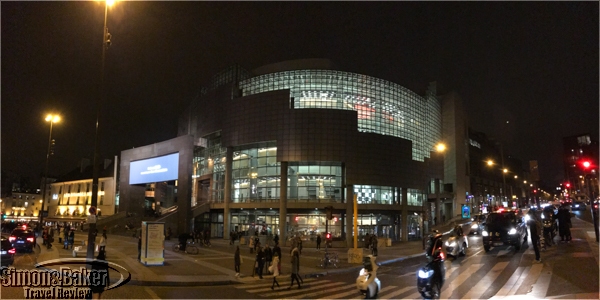Luxury Travel Review

Outstanding guitar concert at handsome new concert hall on outskirts of Paris
By Elena del Valle
Photos by Gary Cox
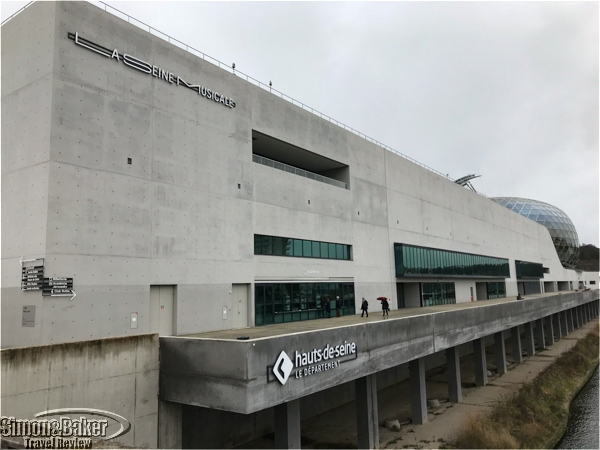
La Seine Musical
On our most recent trip to Paris, France we discovered La Seine Musicale (Ile Seguin, 92 Boulogne-Billancourt, France, www.laseinemusicale.com, + 33 1 74 34 53 53), an events venue opened in 2017 on the outskirts of the city.

The venue is on an island in the center of the Seine River just outside Paris.
The building, situated on the Seguin Island, has a distinctive architectural design. Inside natural lit filtered past wood and glass walls, drawing us our gaze across the river. The high ceiling gave the building a sense of space.
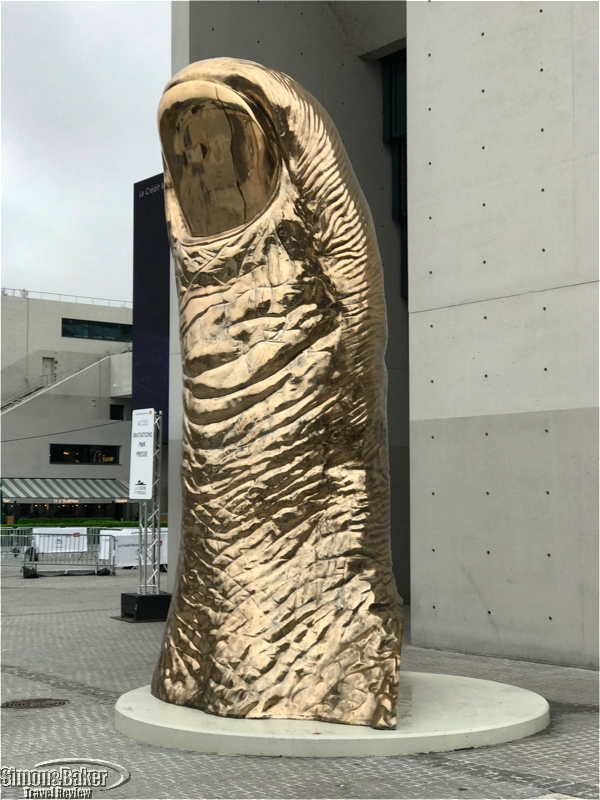
There was a huge sculpture of a thumb in front of the building.
We attended a one hour and fifty minute guitar performance by Liat Cohen accompanied by tenors Rolando Villazon and Charles Castronovo, soprano Sandrine Piau and the Orchestre Pasdeloup. They performed works by Joaquin Rodrigo, Enrique Granados, Jules Massenet, Gabriel Faure, Francisco Tarrega, Isaa Albeniz, Manuel de Falla, Fernando Sor, Tomas Barreras, Rafael Calleja and Tomas Breton. They were fresh from recording Paris-Madrid, an album, that year. It was available for purchase outside the concert hall. Liat’s guitar playing was excellent, earning her repeated applause. It was my favorite part of the show.
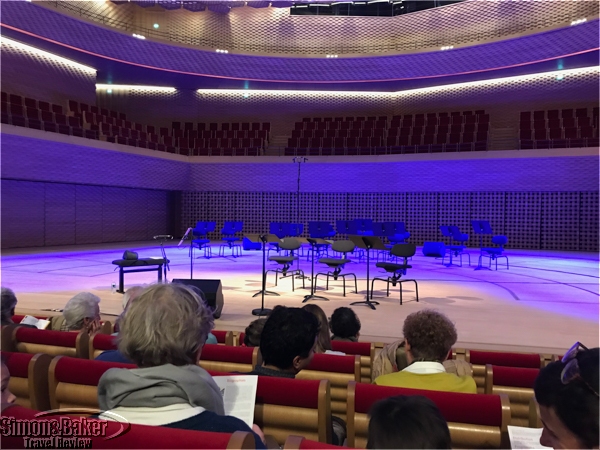
The stage minutes before the start of the performance.
According to her biography Cohen earned First Prize at the Paris Conservatory, graduated from the Schola Cantorum and the École Normale de Musique de Paris; and was the first guitarist to have received the Nadia Boulanger Prize from the Foundation of France.
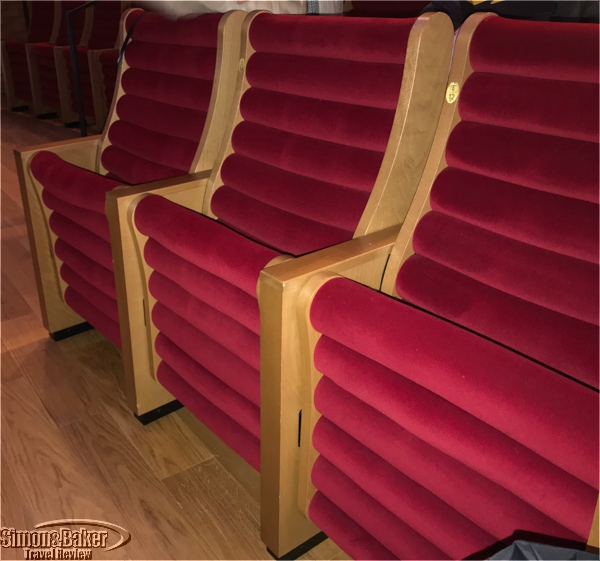
The seats were comfortable and solid.
Our seats (Category 1, E8-10) were comfortable and the view to the stage was unobstructed. Due to photography restrictions we were unable to take photos once the musicians began playing and singing.
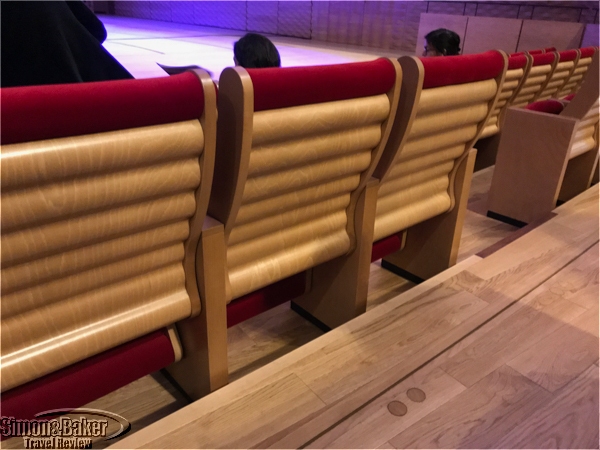
The backs and arms of the seats were blonde wood.
I had read in advance about La Seine Musicale’s rooftop garden, but despite several attempts on arrival and departure it was impossible to visit the garden. Once inside the staff said we couldn’t reach the garden and weren’t allowed to exit and re-enter. At the conclusion of the afternoon show the staff member I spoke with indicated the roof garden was closed.

The walls and ceiling of the theater were covered with a variety of textures and materials.
The theater had two halls with a maximum capacity of 6,000 during 150 shows and an approximate annual attendance of 350,000. The name was derived from the River Seine and the French name for stage, Scène. It was a public private partnership owned by STS Evenements, a joint venture between TF1 and Sodexo.
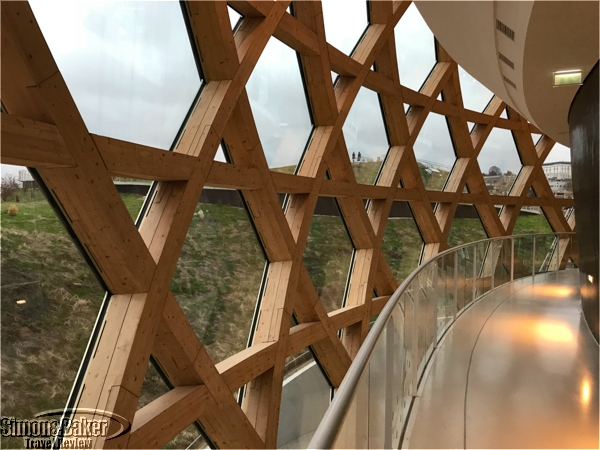
The interior of the dome looking out through solid wood supports
The greatest challenge was that from the Left Bank in central Paris it took us about one hour to reach La Seine Musicale. For a worthwhile performance I would attend a concert there again and recommend it to friends.
Central Florida restaurant focused on southern cuisine with modern twist
Article and photos by Elena del Valle
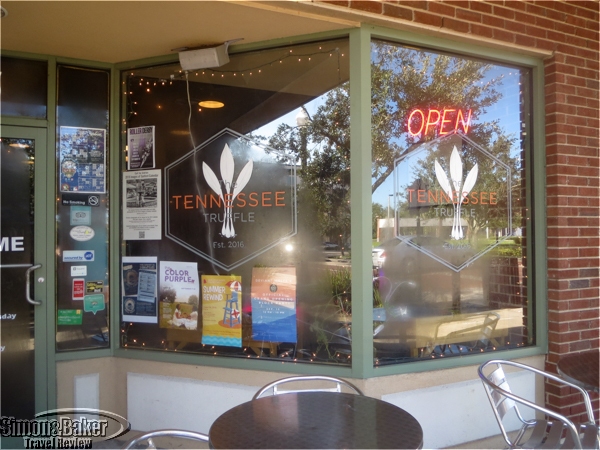
The Tennessee Truffle in Historic Downtown Sanford, Florida
Breakfast at The Tennessee Truffle (125 west 1st street, Sanford, Florida 32771, thetennesseetruffle.com, +1 407-942-3977) in Historic Downtown Sanford, Florida was fun and tasty. We were among the first patrons to arrive on a low season Saturday morning. It was quiet inside the 2,000 square foot restaurant established in 2016 by Nat Russell, owner and chef, as “a family restaurant using sustainable ingredients to make southern cuisine with a modern twist.”
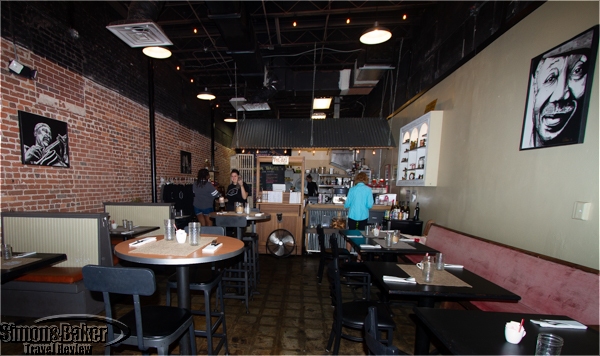
Inside the 2,000 square foot restaurant
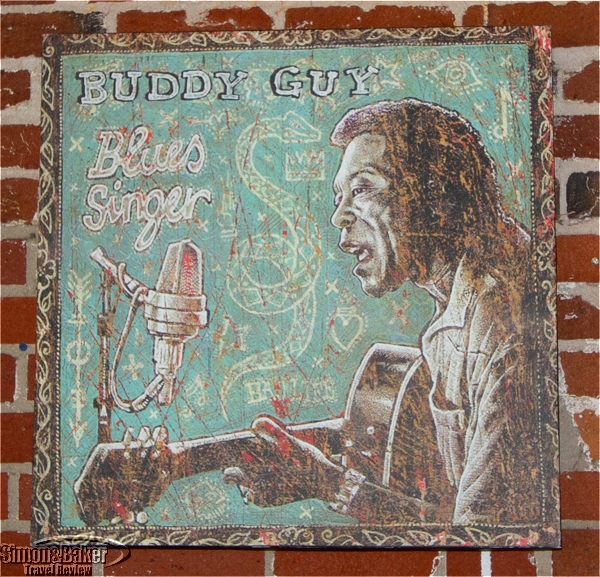
Art on the walls of The Tennessee Truffle
From the breakfast mains we had Biscuits & Gravy and French Toast. Both were well prepared and presented. They were worth ordering on a second visit should I return to Sanford and recommending to friends who like southern cuisine. The smoked maple syrup in the French Toast gave the dish a pleasant if unexpected savory flavor. From the sides menu we ordered Grits with sorghum and crushed pecans; and pan seared Duroc Bacon, a 12-day house-cured bacon, which was more like ham. While grits are not a favorite dish in general I enjoyed those. To wrap it all we shared an order of Popcorn Brulee made with three forms of popcorn, ice cream, powder and brulee.
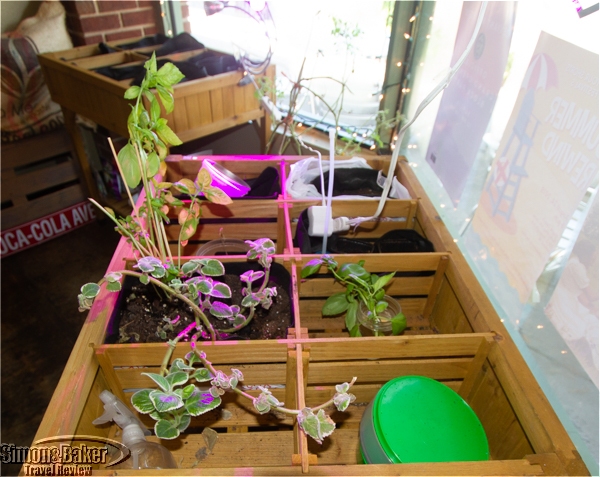
Plants grew next to the window in elevated wood planters
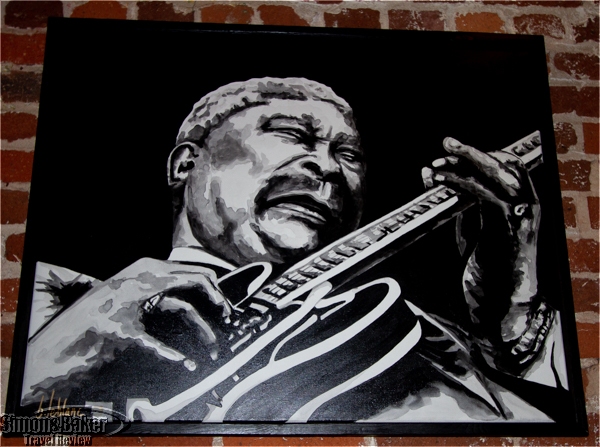
Our server was patient, friendly and helpful. When she didn’t know the answer to a question she found out and returned with the information.
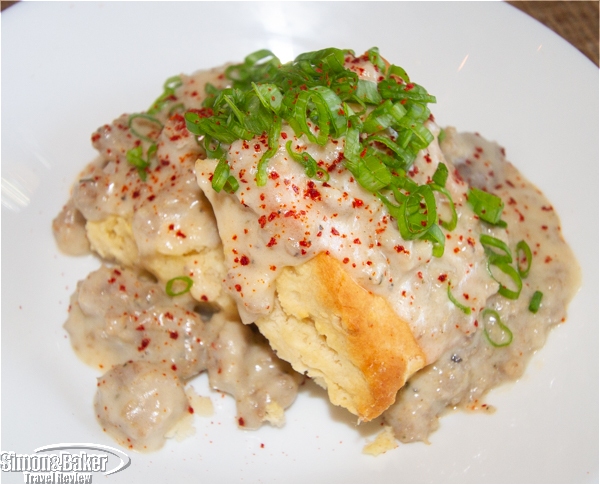
Biscuits & Gravy
Partway through our meal when the chef came out to bring a dish he graciously answered questions and posed for photos. “We are a restaurant using as much local produce and protein as possible,” Russell, said by email later when asked about sourcing for the restaurant. “I believe in using the best product. If that’s from Sanford great but I won’t compromise flavor or freshness just to be local. If it’s from the area all the better!”
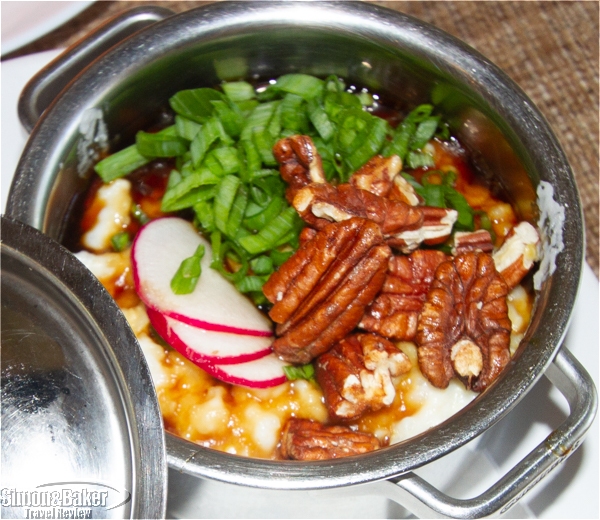
Grits with sorghum and crushed pecans
He went on to explain that everything they use is organic, about 50 percent of produce is from Florida, about 80 percent of the fish served is local, and 100 percent of the beef and beer is from Florida. A Culinary Institute of America graduate Russell, Memphis born, is former executive chef of Winter Park’s Café de France in Florida.
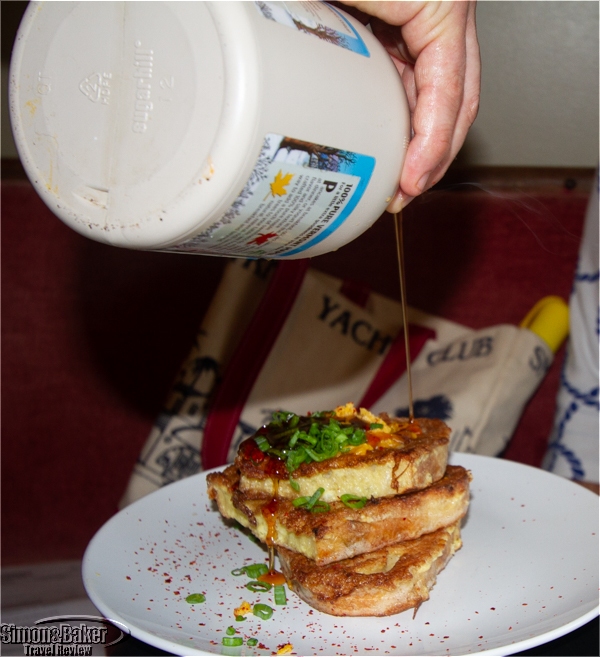
Smoked maple syrup on our French Toast gave the dish a savory flavor
When asked about the name of the restaurant he said, “ In the Appalachian mountains the first thing to pop out of the ground in the spring is the ramp. They call this the Tennessee Truffle I love this story. So, I stole the name and the rest is history!”

Duroc Bacon, a 12-day house-cured bacon
I liked the chef’s light touch. The dishes I sampled had seasoning that allowed the ingredient’s natural taste to shine. I appreciated his flair for surprising and unexpected flavors and textures such as the smoked maple syrup in his French Toast, the crunchy pecans in the grits and the three textures of popcorn, (powder, creamy brulee and ice cream) in the Popcorn Brulee.
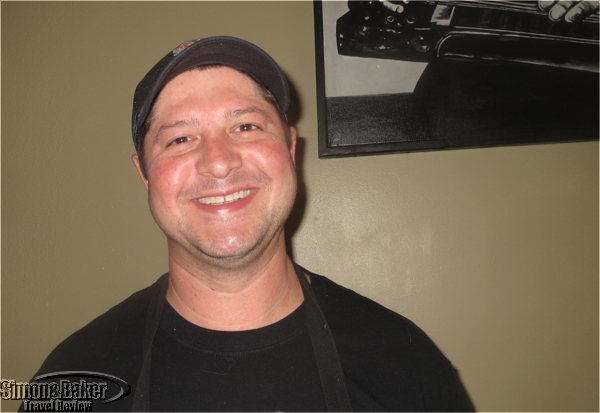
Nat Russell, owner and chef
The restaurant’s light filled dining room was inviting and relaxed, the chairs comfortable. I wondered if the chef had used any of the herbs growing in pots between our table and the street facing window in our breakfast. The pleasant setting, warm and efficient service and lovingly prepared dishes made me want to return.
An afternoon workshop at Paris jeweler
By Elena del Valle
Photos by Gary Cox and Elena del Valle*
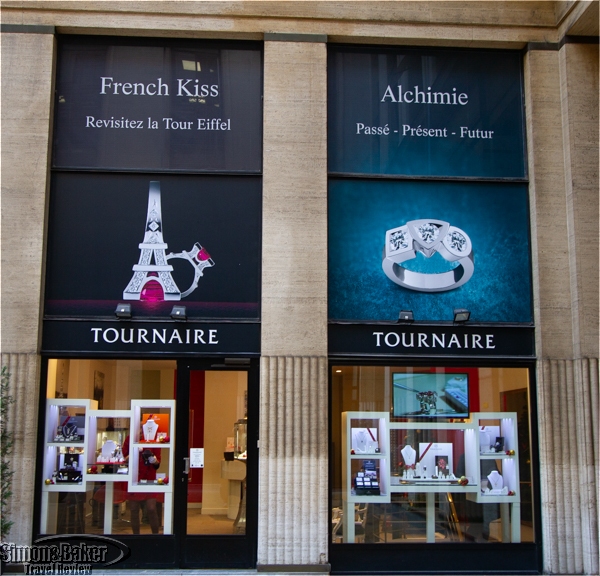
The exterior of the Maison Tournaire shop steps away from the famous place Vendome
It was a chilly and clouded Friday afternoon when I arrived at Maison Tournaire (7 place Vendôme, Paris, France, +33 4 77960884, www.philippetournaire.com, mathieu.pallay@philippetournaire.com), a stone’s throw from the famous Place Vendome in Paris, France for a small group half-day workshop in French. Perhaps because of the well-known venue and crowded streets it was the kind of activity I suspect most tourists never know exists. It had been raining on and off all day. Despite rushing I was five or ten minutes late. As soon as I entered the boutique the staff made me at ease, explaining the workshop had yet to start. While I was still near the door another attendee arrived, distressed at being late. She had been circling the area in search of a parking place for a long while, she explained, making me feel better about my own tardiness.

The meeting room where the workshop took place
The interior of the shop was well lit and populated with jewel filled glass cases. It was elegant without being intimidating, adult yet youthful. Marie, one of the two staff members, put away our wet raincoats and umbrellas, offering us welcome hot beverages in exchange.
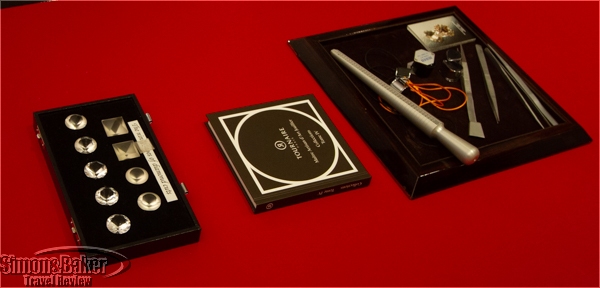
Some of the tools and materials we used during the workshop
After greetings from our host Mathieu Tournaire we climbed one floor upstairs where we sat at a conference table. Mathieu and I had an opportunity to chat earlier that day when he explained everything the company makes is Tournaire-ized. “We don’t just make jewelry, we tell stories,” he told me with a serious expression in between private appointments with clients. The clean shaven jeweler had a quiet confidence that bellied his youthful appearance and the easy manner of a salesman.
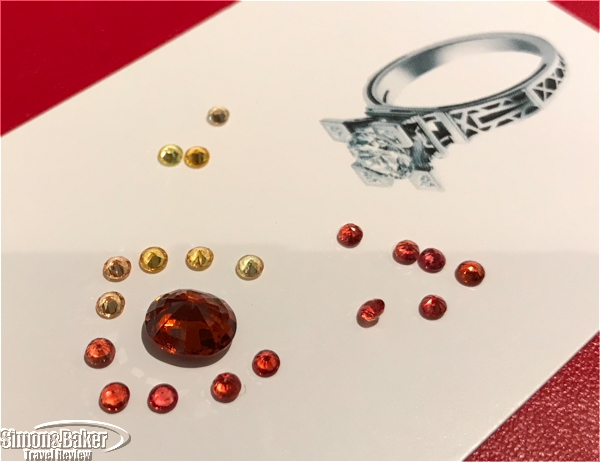
We initially discussed a ring design that could include my yellow and orange sapphires and possibly a large house stone.
Some 15 percent of Tournaire sales were custom orders, he explained. He and his father, Philippe Tournaire, were the creative engines of the firm and both lived outside of Paris. In addition to the Paris location there were stores in Lyon (4 rue Childebert) and Savigneux (2 rue des métiers), where they lived. Whenever he was in town his calendar was full of client appointments.
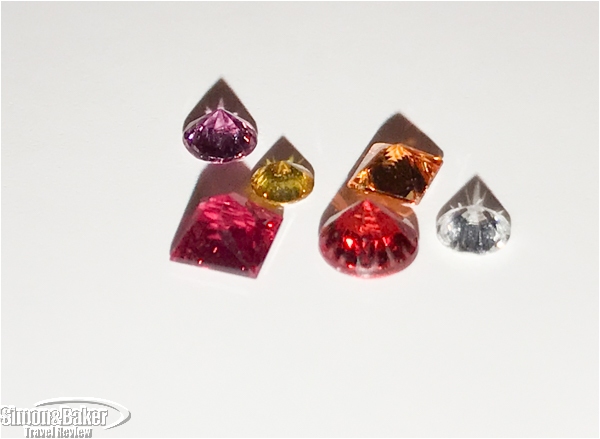
Stones Mathieu selected for the ring
More than half of the attendees had cancelled their workshop reservations because of the soggy weather or the ongoing Yellow Vest demonstrations that riddled France for weeks and peaked on weekends so in lieu of the original nine we were only four. The small group and easy manner of the other attendees made the workshop intimate, allowing each of us to hold tools, rough stones and gemstones in our hands, and observe them with loopes.
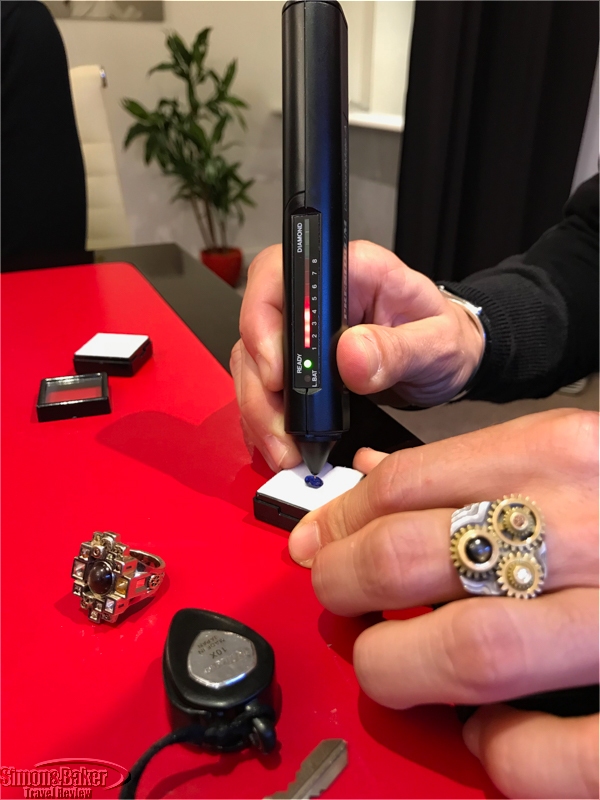
Mathieu demonstrated the use of a device to test diamonds
Mathieu held up a tablet to show us photos, discussing weights, measures, gemstone classifications, varieties and hardness, diamond colors, cuts and facets and demonstrated how to test a diamond with an electronic device. He explained that in France only diamonds, emeralds and sapphires (including rubies) are precious stones. He also discussed opals and star sapphires in passing. Time flew and before I realized it the workshop had ended. At its conclusion we each received a stamped certificate or Certificat de Participation as a souvenir.
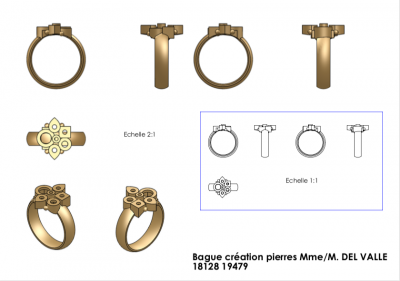
An image of the 3D model for the ring Mathieu designed (*courtesy of Maison Tournaire)
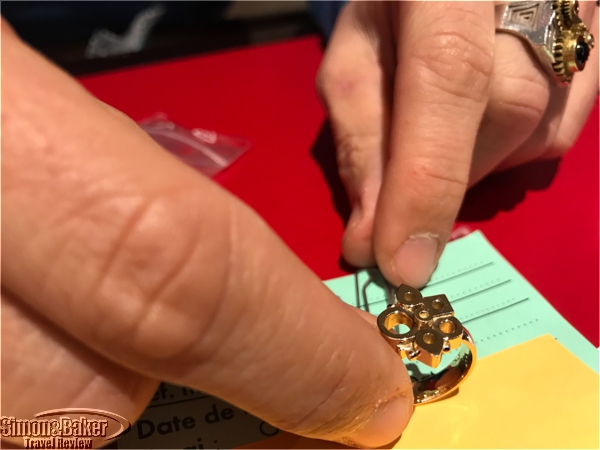
The ring setting Mathieu designed without stones, just the yellow gold part
Once the workshop was over Mathieu spent private time with several of the attendees. Earlier in the day he and I had discussed an idea for a custom made ring. He had drawn a Tournaire-ized concept on a piece of paper and shown me some small gemstones for possible inclusion (diplomatically rejecting my own stones). If all went well, he would share a 3D design via email before making a ring to show me before I left France.
Outside it was dark, but at least the rain had slowed to a drizzle. I didn’t mind the rush hour crowds and wet pavement so much as I walked back to the rue de Rivoli and south toward the Left Bank remembering my fun afternoon.
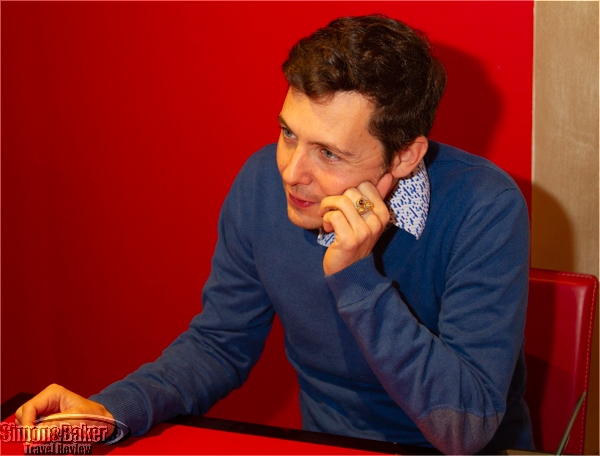
Mathieu Tournaire, artistic director, Maison Tournaire
Maison Tournaire was founded by Philippe Tournaire, a self taught jeweler, in 1973. Mathieu, the artistic director, joined the team in 2008. Maison Tournaire creations were designed to be easily recognized. I had an opportunity to see several of the lines and try on some of the pieces at the shop such as Engrenage (Mathieu wore a distinctive ring of that line), Alchimie, Pensée Sauvage, French Kiss, and Architecture. The ring he created reminded me of the Marélie line, a favorite along with French Kiss.
I liked that Tournaire products were made 100 percent in-house and in France. I appreciated the warm authentic service and efficient follow through. Where attendants at other shops I visited in the place Vendome area were solicitous their welcome was superficial, their demeanor stiff and cool. For example, an eager saleslady on the rue de la Paix offered tax free processing, but could not answer simple questions about the treatment or provenance of her gemstones. Mathieu answered my queries quickly and candidly. One overly inquisitive vendor at a nearby luxury boutique promised to email me information about items they expected to receive, but I never heard from him. In contrast Mathieu and his staff were helpful and responsive without ever being pushy. After the workshop he followed up promptly with the drawing and 3D design we had discussed. Likewise Marie was in touch promptly to schedule a new appointment.

The stones resting on the setting allowed us to see how the finished ring might look.
Two weeks later when Mathieu returned to Paris he brought a 12 by 15 millimeter 18 karat yellow gold ring to show me. It weighed 8 grams and was priced at 3,900 euros. The stones he selected were: 5 millimeter tourmaline rubellite (a red tourmaline), 3 millimeter round red sapphire, 3 square millimeter orange sapphire, two color diamonds of 0.06 carats each, and a white 0.04 diamond. The ring was unfinished, but by placing the gems in their settings it was easy to imagine what it would look like. I especially liked that the diamonds were slightly elevated to protect the other stones. As the hardest stones diamonds would take the brunt of any impact if the wearer banged the ring by accident.
The ring was temptingly pretty. It reminded me of a friend’s redesigned and repurposed wedding ring after her divorce. Every time she looked at it her eyes sparkled with delight. Despite my interest by then my budget had already been fully allocated. Who knows, the next time I am in Paris and have a milestone to celebrate I might pop into Tournaire and say hello. I wouldn’t hesitate to recommend the workshop to friends with an interest in French jewelry wanting an off the beaten track experience in Paris. I would also recommend the shop to those in the market for the brand’s distinctive style.
Outstanding performance at Paris Opera Bastille
By Elena del Valle
Photos by Gary Cox, performance photos courtesy Opera National de Paris (OnP)*
The exterior of the Opera Bastille (click for full size)
In December we attended a most enjoyable sold out performance of La Traviata at the Paris Opera Bastille. The opera by Giuseppe Verdi with the orchestra and chorus of the Opera National de Paris began at 7:30 p.m. and concluded at approximately 10:40 p.m. Ticket prices ranged from 5 euros to 231 euros. Our tickets were in Optima Class in the Parterre section (7A97 and 7A98). In order to have an clear view of the stage I had to switch sweats.
The modern architecture of the Opera Bastille viewed from near the stage (click for full size)
The opera was divided into three acts. The first act lasted 35 minutes followed by a 30 minute intermission. The second part lasted just over one hour and was followed by a 25 minute intermission. The final act lasted 35 minutes.
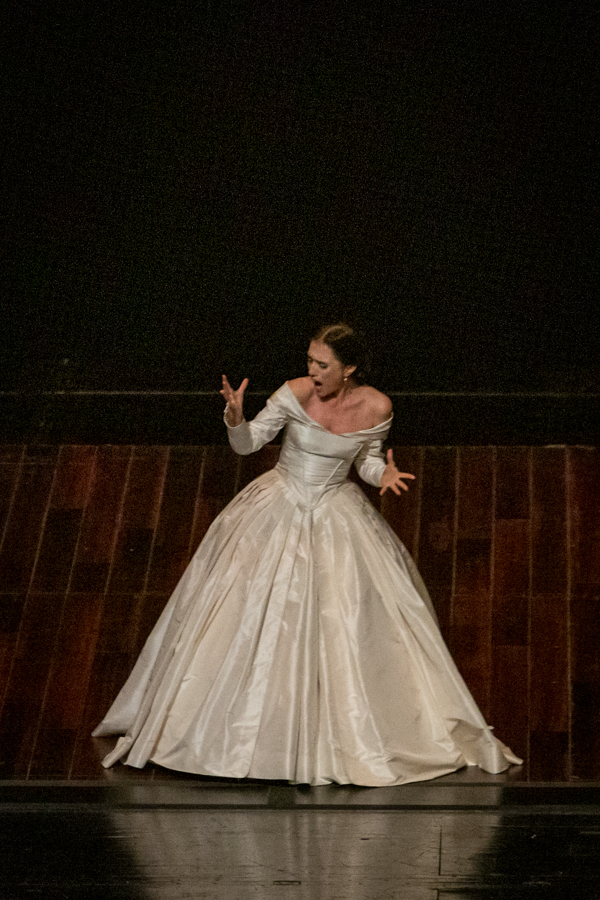
Ermonela Jaho was Violetta – (c) Sébastien Mathé – OnP
While the first act was the biggest crowd pleaser we, and judging by the enthusiastic applause the rest of the attendees, liked the entire opera. There was a gender bending scene that raised some eyebrows. A man seated next to us took exception to the orchestra, booing on multiple occasions.
It was toasty warm inside the theater. The only sour notes were the hard to find box office, where we had to run at the last minute due to processing issues with our credit card, and the pungent urine smell in the ladies room nearest to our seats.
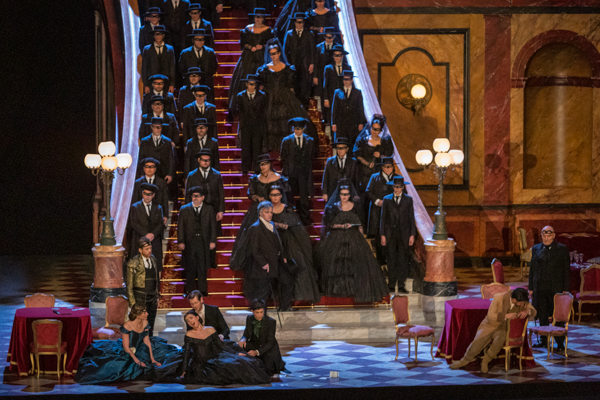
Dramatic staging for a confrontation – (c) Sébastien Mathé – OnP
The program was in French and English. Supra-titles high above the stage and on screens on either side of it provided French and English translations of the original Italian. We could watch the stage or read the supra-titles at any one time. We could only read the text above the stage. After a few minutes our necks tired from holding them at an angle to read the supra-titles at the top.
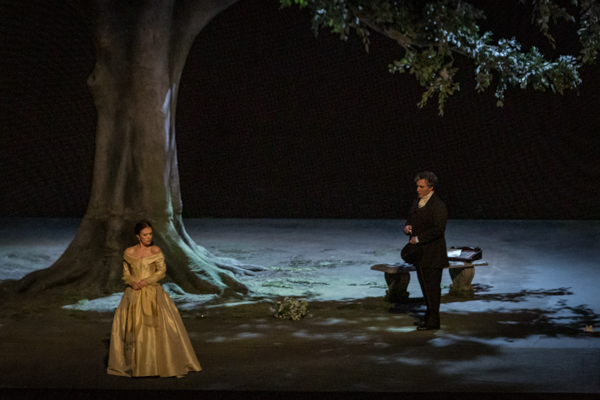
Giorgio asking Violetta to forsake his son. – (c) Sébastien Mathé – OnP
The following contributed to the production: Karel Mark Chichon, conductor; Benoit Jacquot, director; Sylvain Chauvelot, set designer; Chrisian Gasc, costume designer; Andre Diot, in charge of lighting design; Philippe Giraudeau, choreography; and Alessandro Di Stefano, chorus master.
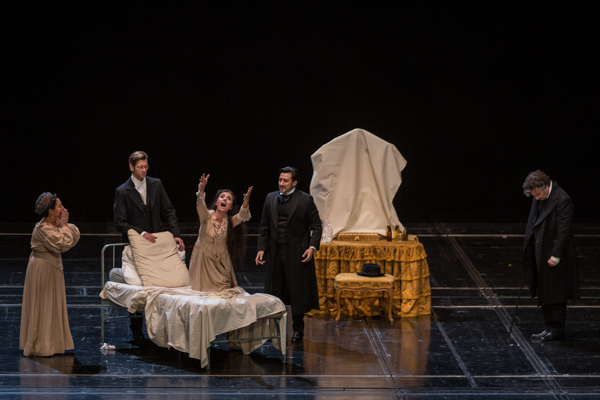
The dramatic final scenes – (c) Sébastien Mathé – OnP
Ermonela Jaho’s Violetta was energetic and moving. Ludovic Tezier enhanced the performance with his powerful Giorgio. At the conclusion the audience clapped for several minutes. It was a superb evening of entertainment and one that will draw me back to the Opera Bastille in the future.
*The Opera National de Paris did not allow photography during the performance. The photos they provided were dated from the Dec 11th, 2018 performance.
Happy New Year!
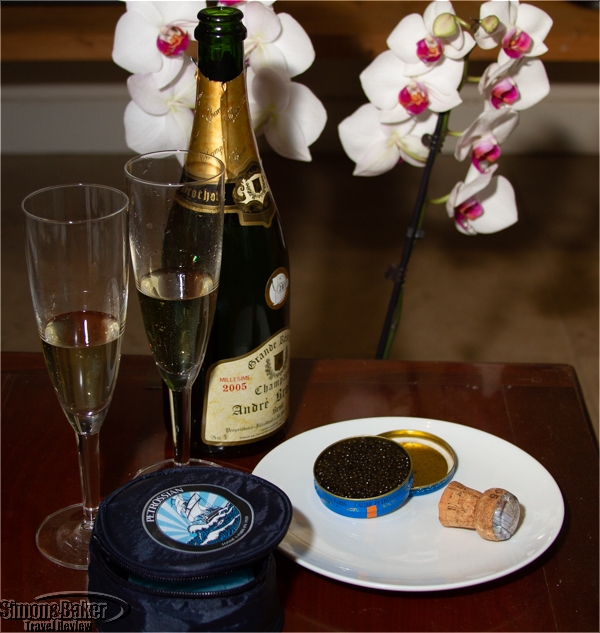
Best wishes for a prosperous New Year!
Florida small batch factory new favorite for dark chocolate
By Elena del Valle
Photos by Gary Cox
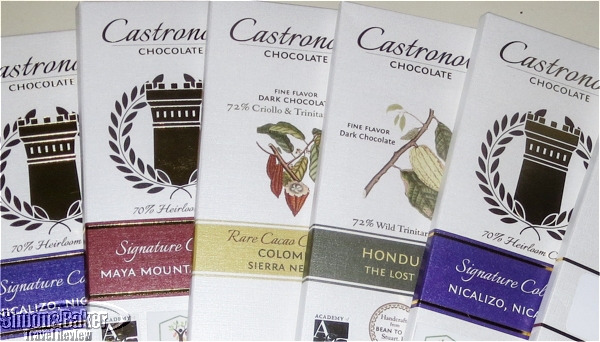
Castronovo bean to bar chocolates from individual countries
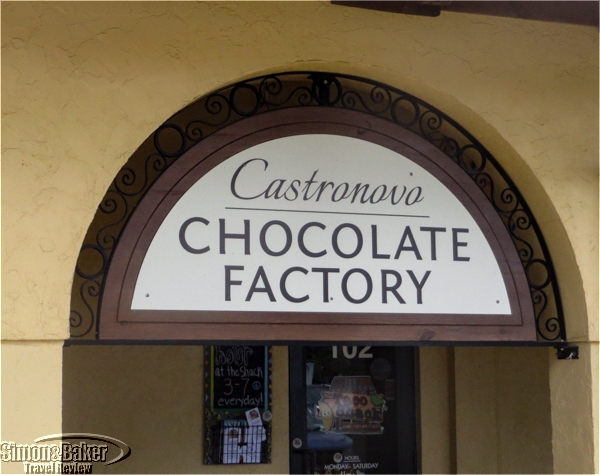
The Castronovo Chocolate Factory in Stuart, Florida
I had sampled Castronovo small batch craft chocolate several times before I made it to the 725 square foot shop and factory in Stuart, Florida. The rich dark chocolate 2.2 ounce single origin bars had made a fan out of me. I liked their distinctive yet nuanced flavors of the dark chocolate bars and that they were made with only three ingredients: cocoa beans, organic cane sugar, and cocoa butter.
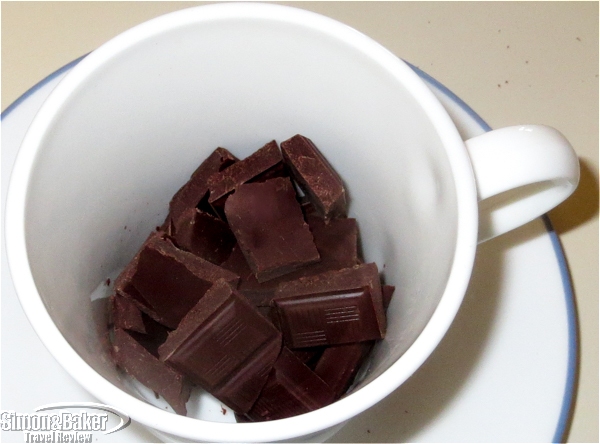
Pieces of a Castronovo bar ready for hot water
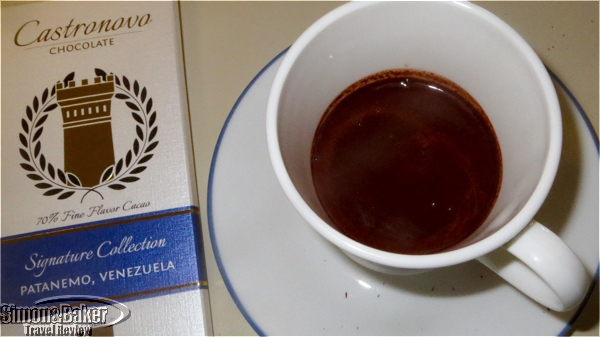
The Patanemo, Venezuela dark chocolate melted in a small amount of water tasted fantastic
Whether it was in a hot chocolate beverage or in morsels the chocolates I tried were head and shoulders above the supermarket bars and some gourmet bars. The day of our visit we tasted the 70 percent Hurricane Relief Benefit Bar from Hacienda Jeanmarie from Puerto Rico and ordered two batches of fresh baked chocolate chip cookies. The bar was inside a sealed foil envelope with a paper wrapper. Handwritten on the back was the batch number and the expiration date more than a year later.
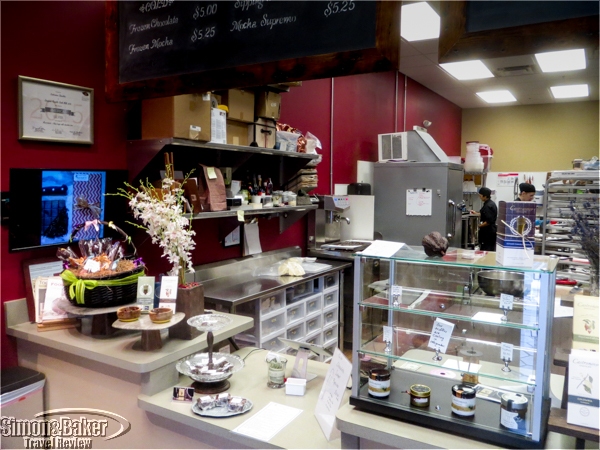
The shop doubled as a chocolate factory
I later found out the shop carried chocolate from eight vendors in Belize, Nicaragua, Colombia, Venezuela, Honduras. Because organic certification is expensive for farmers to obtain, the shop only sold two origins certified organic, Belize and Honduras, the owner explained by email.
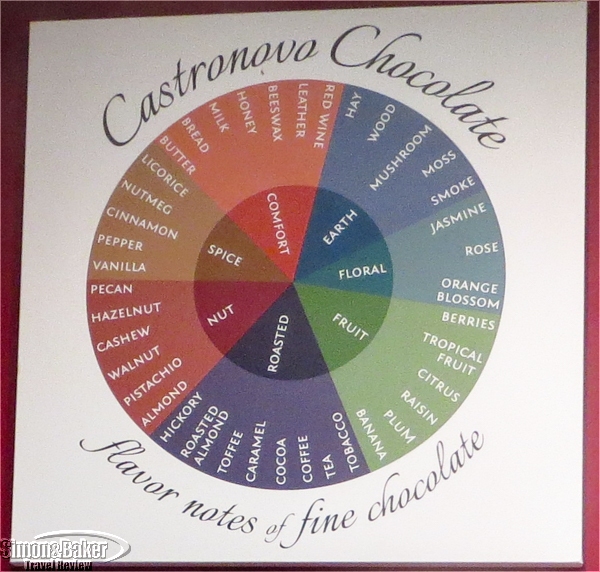
A sign on the wall at the shop
“We are very selective in choosing our producers,” Denise Castronovo said by email when asked about the selection criteria for her factory. “First off, the cocoa beans need to be produced using fair labor practices. Usually the beans come from family farms or indigenous communities. Since cacao is an understory shade crop, we seek out producers who typically are gathering the cacao in a rainforest environment rather than from plantations. Many of our cocoa beans are grown in the wild and simply harvested. Finally, when all of these criteria are met, we consider the flavor profile and looks for fine flavors that are unique to our line of chocolate and are not flawed by any errors in the fermentation.”
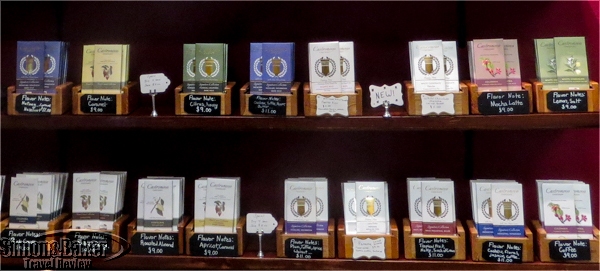
Each bar was on display with a handwritten description of its most distinctive flavor notes.
When asked how she chooses new suppliers she replied, “We require that our new suppliers be transparent about their sourcing to ensure that the farmers are paid fair wages. We work closely with suppliers who provide technical expertise on the post-processing fermentation and drying to ensure that the bean quality develops fine flavors and consistency. We purchase our cacao through direct trade which means that the cacao is not sold on the commodity market and there is price transparency throughout the supply chain to ensure that farmers receive a fair wage.”
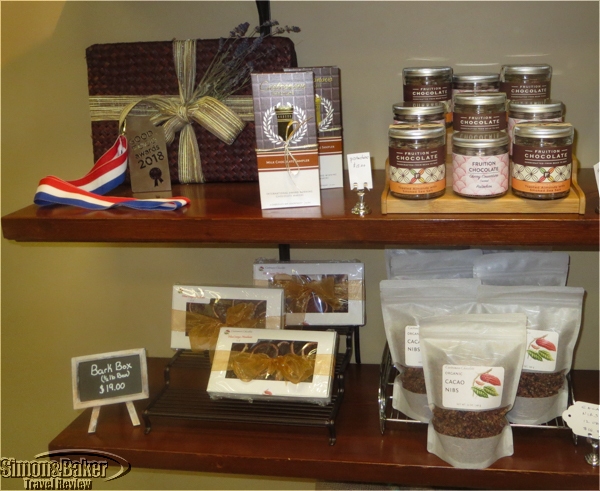
Chocolate products for sale at the shop
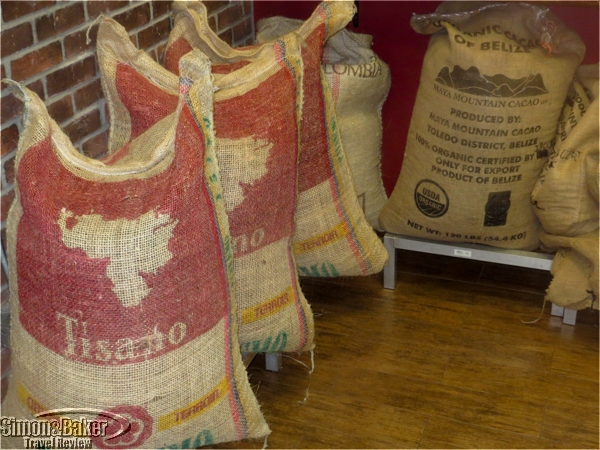
The original cocoa bags were on display, waiting to be processed.
It was too early for the cookies, making it necessary to pay for them and return an hour later when they were cool enough to pack. The staff member who looked after us, a vivacious and enthusiastic woman, was friendly and service oriented. She answered our questions and made suggestions when asked. With her assistance I bought other single origin bars, which I have yet to open. When I wondered about specifics regarding varietals she found a colleague to answer my questions. On the way home we ate most of the Puerto Rico bar, savoring the unctuous chocolate with hints of raisin flavor.
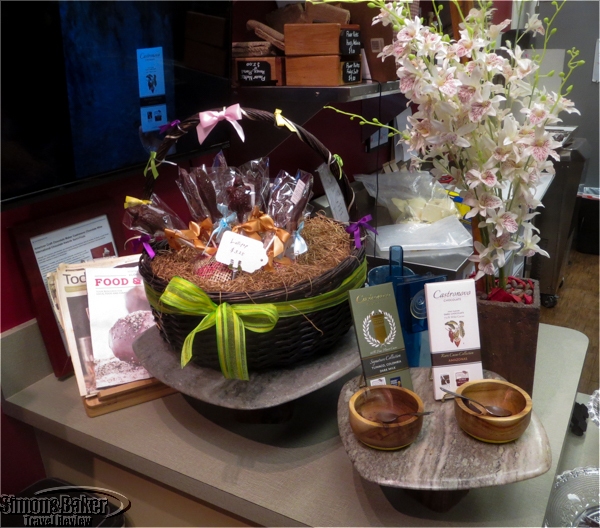
There were samples on the counter.
When asked about staff training Castronovo explained that she instructs hires in factory methods of chocolate making, food safety, chocolatier work, pastry, barista, customer service and education. Over the years, the shop has had staff with professional pastry chef training, which was helpful for new product development.
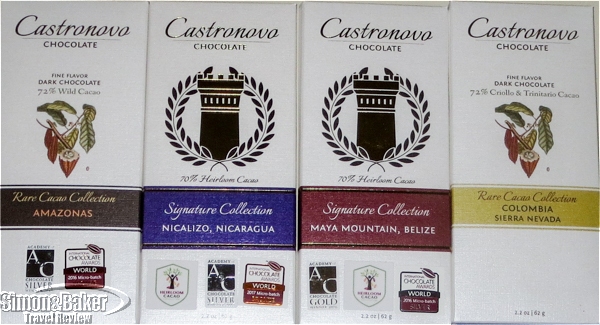
Many of the bars featured awards and certifications on the labels
I have heard some chocolate fans wax poetic about the pedigree of their bean varietal as well as single source origin. When purchasing raw ingredients Castronovo focuses her energy elsewhere, she explained.
“The bean varietal (criollo, trinitario, forester) is not the most important factor – taste is far more important,” she said. “We do seek out heirloom varieties of cacao, whenever possible, so we can preserve the native cacao varieties from a region and discourage plantings of genetic hybrids. There are some genetic hybrids of cacao that we stay away from because they were modified for high production rather than fine flavor and taste terrible.”
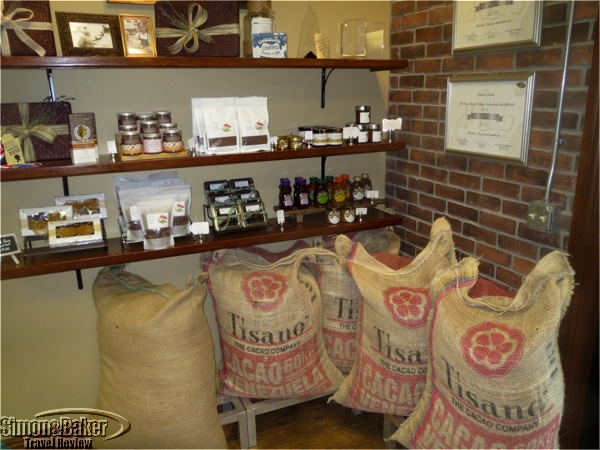
Products for sale and cacao bags inside the shop
She believes in bean to bar single origin production. In that regard she said, “We create small-batch single origin chocolate, so the origin is extremely important. At each origin there are unique cacao genetics and terroir which create different flavors in the final product.”
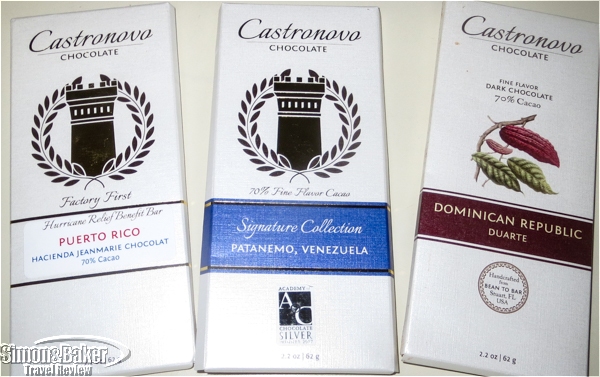
Some of the Castronovo chocolates, including, in the middle, one of our favorite bars
We liked the 70 percent bar from the shop’s Signature Collection, a single origin from Patanemo, Venezuela. We repeated the hot chocolate beverage tasting with Castronovo Chocolate Factory (555 S. Colorado Ave #103, Stuart, Florida 34994, +1 772-521-1699, www.castronovochocolate.com, castronovo@outlook.com) bought chocolate with equally rewarding results. The dark chocolate was a 70 percent cacao from Duarte in the Dominican Republic (no longer available). We also liked the Patanemo Dark Milk 66 percent and Nicalizo, Nicaragua 70 percent bars from the Signature Collection. I look forward to more Castronovo dark chocolate bar tastings in the coming months.

